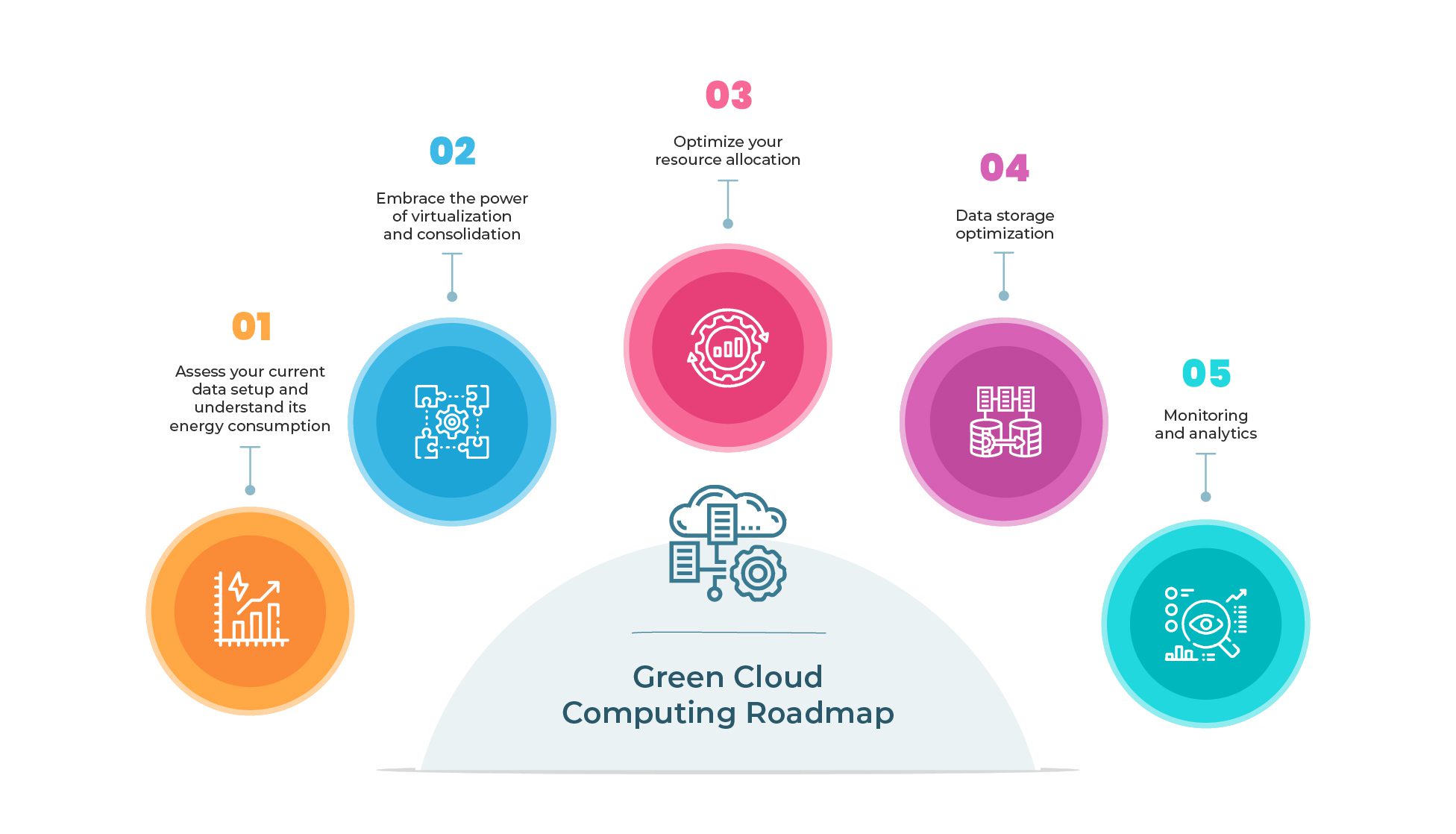Global carbon dioxide emissions from fossil fuels and industry were 36.8 gigatons (Gt) in 2022, according to the International Energy Agency (IEA). This is an increase of 0.9% in energy production from 2021, and the highest level of emissions ever recorded. The IEA projects that global CO2 emissions will continue to rise in the coming years, reaching 42 Gt by 2030 if no additional action is taken to reduce emissions. This would put the world on track for a temperature rise of 2.7 degrees Celsius by the end of the century, which would have devastating consequences for the planet. The clock is ticking for enterprises across the globe as they face mounting pressure to slash their emissions. With regulatory and investor pressures intensifying, they find themselves at a crucial crossroads. The world demands action, and it demands it now. The question is: how will they rise to the occasion? What must they do to not only embrace the challenge but also spearhead the transformation towards a greener tomorrow?
Thankfully there’s a solution and it’s up in the Cloud. Make way for Green Cloud Computing, a revolutionary practice that aims to minimize the carbon footprint and energy consumption associated with cloud infrastructure and operations. It’s all about implementing sustainable strategies, optimizing resource allocation, and promoting eco-friendly practices in enterprise data centers. Join us on this exciting journey as we explore the fascinating world of green cloud computing and its empowering effects on the industries at large. Together, we’ll discover how this remarkable synergy can pave the way towards a greener, cleaner, and more efficient future. So, grab your favorite mug, pour yourself a cup of coffee, and get ready to delve into the realm where cutting-edge technology meets environmental stewardship!
Unmasking the Unknown: The Biggest Cause of Carbon Emissions in Enterprises
In our increasingly interconnected world, data centers have become the driving force behind the smooth flow of information. They are the powerhouses that handle the immense volumes of data we generate every second. However, lurking beneath their efficiency and convenience lies a troubling truth: data centers are major contributors to carbon emissions. It is estimated that globally, data centers account for approximately 3.7% of global greenhouse gas emissions and consume a staggering 3% of the world’s electricity, a figure expected to rise as our reliance on the internet continues to grow. To put this into perspective, data centers consume approximately 200 to 250 terawatt-hours (TWh) of electricity annually. That’s equivalent to Sweden’s entire annual electricity consumption and the carbon emissions produced by the aviation industry. A terawatt-hour, by the way, is a unit of energy equal to a mind-boggling one trillion watts for one hour. And with over 500,000 facilities worldwide, their numbers are only increasing.
Now, here’s where it gets serious. This growth is putting our future in jeopardy. If we continue burning fossil fuels like there’s no tomorrow (quite literally), experts estimate that we’ll run out of these precious resources by 2060. The sheer scale and energy demands of these behemoth facilities mean they rely heavily on fossil fuels, and that’s not good news for our environment. Cooling systems, constant server operation, and redundant infrastructure all contribute to this substantial energy demand. The consequences are clear: copious amounts of greenhouse gases are released into the atmosphere, endangering our future.
However, amidst this challenge, several enterprises are beginning to embrace sustainable practices and innovative solutions. Enter Green Cloud Computing, a crucial ally in the journey toward greener data centers. By prioritizing energy efficiency, optimizing resource allocation, and adopting eco-friendly technologies, data centers can significantly reduce their environmental impact. This shift is vital not only for the well-being of our planet but also for creating a more sustainable and responsible digital future. It is high time enterprises recognize the urgency and take decisive action to transform data centers into eco-conscious powerhouses.
Green Cloud Computing: Guiding the Way to Net Zero with 5 Impactful Strategies

Amidst the urgent global push for sustainability, the spotlight is firmly on achieving a net zero future. In this critical pursuit, green cloud computing shines as a beacon of hope, reshaping our approach to harnessing and utilizing digital resources. By leveraging cloud computing technologies and services in an environmentally sustainable and energy-efficient manner, green cloud computing aims to mitigate the carbon footprint and overall environmental impact associated with data centers and IT infrastructure. Through the adoption of eco-friendly practices, optimization of resource utilization, and reduction of energy consumption, it paves the way for a future where environmental harm is minimized and the dream of achieving a net zero reality becomes tangible. Studies have shown that migrating to the cloud can lead to savings of up to 87% in IT energy consumption. This remarkable statistic highlights the tremendous opportunity to significantly reduce our energy footprint by embracing cloud-based solutions.

Within the realm of green cloud computing, several transformative strategies have emerged as catalysts for change. Let’s delve into the top five strategies that are reshaping the landscape:
- Unlocking the Potential of Server Virtualization: Green cloud computing embraces server virtualization as a key strategy, delivering a host of advantages. Through virtualization, servers achieve remarkable utilization rates of 60-80%, leading to unprecedented energy savings of up to 80%. Studies have unveiled the immense potential of virtualized environments, illustrating their ability to outshine non-virtualized counterparts.
- Embrace the Power of Renewable Energy: In the pursuit of environmental sustainability, the adoption of renewable energy sources is paramount. Visionary organizations like Microsoft are leading the charge, committing to powering their data centers with 100% renewable energy. In 2020, Microsoft achieved a remarkable feat by attaining a renewable energy usage rate of 100%. This inspiring achievement sets an example for others to follow, highlighting the transformative impact of renewable energy adoption.
- Unleashing Energy Efficiency Innovations: Energy efficiency lies at the core of greener data centers. By implementing energy-efficient designs and infrastructure upgrades, data centers can unlock substantial energy savings. Google, for instance, achieved a groundbreaking power usage effectiveness (PUE) rating of 1.10, signifying unparalleled efficiency in their operations. Compared to the industry average PUE of 1.67, this remarkable feat underscores the vast potential for improvement within the industry.
- Consolidation for a Sustainable Future: Data center consolidation, fueled by virtualization and cloud migration, offers a sustainable solution to reduce energy consumption and costs. The U.S. Federal Aviation Administration (FAA) serves as an inspiring example, consolidating their data centers from 23 to 2. This consolidation effort led to annual energy savings of approximately $15 million, showcasing the tangible benefits that can be achieved through strategic optimization.
- Responsible Data Lifecycle Management: In the realm of green cloud computing, data lifecycle management takes center stage. Cloud service providers assume responsibility for the proper disposal and recycling of hardware, ensuring electronic waste is managed in an environmentally responsible manner. This commitment to sustainable practices minimizes the detrimental impact on the environment. A comprehensive study by the esteemed McKinsey Global Institute estimates that green cloud computing has the potential to save a staggering 629 million metric tons of carbon dioxide emissions by 2025.
The Green Vanguard: How Cloud Providers are Championing Green Cloud Computing
Cloud service providers are vital in promoting green cloud computing and driving sustainability within the industry. They have recognized the importance of reducing their environmental footprint and have undertaken various initiatives and commitments towards achieving that goal. Here are some examples of the efforts made by major cloud providers:
Google Cloud:
- Commitment to operate on 24/7 carbon-free energy by 2030. Google aims to eliminate its carbon legacy and become the first major cloud provider to run completely on carbon-free energy.
- Investment in renewable energy projects, including wind and solar, to offset its carbon emissions.
- Development of innovative cooling technologies for data centers, such as using seawater for cooling and advanced temperature management systems.
Amazon Web Services (AWS):
- The AWS Carbon Reduction Initiative aims to achieve a 50% reduction in carbon emissions by 2030 and net-zero emissions by 2040.
- Utilization of renewable energy sources to power data centers, with a commitment to achieve 100% renewable energy usage.
- Investment in wind and solar farms, including the construction of utility-scale solar projects, to support clean energy generation.
Microsoft Azure:
- Azure has committed to becoming carbon negative by 2030, removing more carbon from the atmosphere than it emits.
- Microsoft is investing $1 billion in a Climate Innovation Fund to accelerate the development of carbon reduction, capture, and removal technologies.
- Adopting an internal carbon fee, where Microsoft charges its business units for their carbon emissions, incentivizing them to reduce their environmental impact.
IBM Cloud:
- IBM has set a target to achieve net-zero greenhouse gas emissions by 2030.
- Emphasis on energy-efficient data centers, utilizing technologies like water cooling and advanced power management systems.
- Investment in research and development for sustainable technologies, such as energy-efficient hardware and renewable energy integration.
Efficient Data Management: The Gateway to Embracing Green Cloud Computing
Data plays a pivotal role in the adoption of cloud computing and green cloud computing, offering transformative potential. As organizations make the transition to the cloud, data becomes the lifeblood that fuels innovation and sustainability. By harnessing the vast capabilities of data, businesses can unlock valuable insights, optimize resource allocation, and make data-driven decisions that drive efficiency and environmental responsibility. Data analysis empowers organizations to identify energy consumption patterns, optimize efficiency, and implement sustainable practices. With data as their compass, organizations can navigate the path towards embracing the cloud and green cloud computing, unlocking a world of possibilities for a more efficient and eco-friendly future.
- Data-Driven Decision Making: The scalability of cloud computing enables organizations to collect, store, and analyze massive amounts of data. By leveraging this data, businesses can gain valuable insights into their operations, resource utilization, and energy consumption patterns. Data analysis facilitates informed decision-making, identifying areas for improvement, optimizing energy usage, and implementing sustainable practices.
- Energy Efficiency Optimization: Data provides insights into energy consumption patterns and reveals areas for efficiency improvement. By analyzing data related to server utilization, workload distribution, and cooling requirements, organizations can identify opportunities to optimize energy efficiency. Cloud providers can minimize energy consumption through data-driven strategies such as virtualization, workload consolidation, and dynamic resource allocation, all while maintaining performance.
- Resource Allocation and Optimization: Data helps cloud providers effectively allocate computing resources. By understanding resource demands, usage patterns, and performance metrics through data analysis, providers can optimize resource allocation to avoid overprovisioning and underutilization. This ensures efficient utilization of computing resources, reducing energy consumption and its associated environmental impact.
- Predictive Analytics for Energy Optimization: Data analysis and predictive analytics play a significant role in green cloud computing. Organizations can predict energy demands, optimize cooling systems, and implement energy-efficient practices by analyzing historical data and utilizing machine learning algorithms. Predictive analytics identifies potential energy-saving opportunities and enables proactive measures to reduce environmental impact.
- Sustainability Reporting and Accountability: Data collection and analysis enable organizations to track, measure, and report their sustainability efforts accurately. By monitoring key performance indicators (KPIs) and environmental metrics, organizations can demonstrate their commitment to green cloud computing, set sustainability goals, and transparently report progress. Data-driven sustainability reporting fosters accountability and encourages continuous improvement.
- Performance Optimization: Data analysis helps organizations optimize performance while minimizing energy consumption. By identifying performance bottlenecks, resource-intensive processes, and energy-hungry applications, organizations can fine-tune their systems for optimal performance and energy efficiency. This optimization reduces energy waste and contributes to greener computing.
Green Cloud Computing Roadmap: 5 Steps to Prepare Your Data Infrastructure for a Sustainable Future

Let’s kick off your journey toward a greener and more efficient data infrastructure!
The first step is to assess your current data setup and understand its energy consumption and environmental impact. Dive into the nitty-gritty details by gathering data on resource utilization, energy usage, and carbon emissions. This assessment acts as a baseline to measure progress and set targets for energy efficiency. Knowledge is power, and understanding where you stand is key to making meaningful improvements.
Next up, it’s time to embrace the power of virtualization and consolidation. Virtualization technologies allow you to consolidate your computing resources by running multiple virtual servers on a single physical server. This reduces the number of machines needed and opens the door to optimized resource usage, lower energy consumption, and improved efficiency. It’s like decluttering your data center and making it work smarter, not harder.
To further optimize your resource allocation, let’s talk about load balancing. By implementing load balancing algorithms, you can evenly distribute workloads across servers, preventing any single machine from getting overwhelmed and unnecessarily guzzling energy. It’s all about finding that sweet spot where your resources are allocated efficiently, leading to better energy efficiency and top-notch performance.
Now, let’s zoom in on data storage optimization. There are clever techniques you can employ to minimize energy consumption in this area. Consider implementing data deduplication and compression to reduce your storage requirements. Additionally, you can explore tiered storage, where frequently accessed data resides on high-performance drives, while less frequently accessed data is moved to lower-energy-consuming storage tiers. These practices optimize your storage space and slash the energy needed for data storage.
But hey, we’re not done yet! Monitoring and analytics play a crucial role in your journey towards a greener data infrastructure. It’s time to implement comprehensive tools that allow you to keep a close eye on energy usage and environmental metrics. Real-time monitoring of power consumption, cooling efficiency, and resource utilization gives you valuable insights into your data center’s operations. And with the power of analytics, you can spot inefficiencies, predict energy demands, and optimize energy usage like a pro. Armed with data-driven insights, you’ll be equipped to make informed decisions that lead to greener and more efficient operations.
So, let’s get started! Assess your data infrastructure, embrace virtualization and consolidation, optimize resource allocation, fine-tune your data storage practices, and keep a watchful eye through monitoring and analytics. With each step, you’ll inch closer to a data ecosystem that’s not only more environmentally friendly but also more cost-effective and sustainable.
Unveiling the Success Stories: Real-Life Use Cases and Benefits of Green Cloud Computing
While cloud providers often lead the way in implementing green cloud computing practices, there are also other companies across various industries that have achieved significant carbon emission reductions through the adoption of green cloud computing. Here are a few examples:
- Walmart: As one of the world’s largest retailers, Walmart has embraced green cloud computing to drive sustainability in its operations. The company migrated its e-commerce platform to the cloud, resulting in increased energy efficiency and reduced carbon emissions. By leveraging cloud technologies, Walmart achieved a 15-30% reduction in energy consumption, resulting in an estimated 460,000 metric tons of carbon dioxide emissions avoided annually. [Source: Walmart Corporate Sustainability Report]
- Siemens: Siemens, a global conglomerate operating in various industries, has leveraged green cloud computing to enhance sustainability. The company utilizes cloud-based software platforms to optimize energy management and reduce energy consumption in buildings and industrial processes. By analyzing data and applying intelligent algorithms, Siemens has helped its customers achieve energy savings of up to 30% and reduce carbon emissions by an estimated 80 million metric tons. [Source: Siemens Sustainability Report]
- Schneider Electric: Schneider Electric, a leader in energy management and automation solutions, has integrated green cloud computing into its offerings. The company leverages cloud-based platforms to collect and analyze data from buildings, industrial facilities, and energy grids. By optimizing energy usage and implementing energy-efficient practices, Schneider Electric’s enabled its customers to achieve energy savings of up to 30% and reduce carbon emissions by an estimated 70 million metric tons. [Source: Schneider Electric Sustainability Report]
- Philips: Philips, a renowned technology company focused on healthcare and lighting solutions, has embraced green cloud computing to drive sustainability across its operations. By utilizing cloud-based platforms for data analysis and management, Philips has improved energy efficiency in its lighting systems, optimized resource allocation, and reduced the environmental impact of its products and services. The company helped customers achieve energy savings of up to 80% and reduce carbon emissions by an estimated 32 million metric tons. [Source: Philips Sustainability Report]
- BMW: BMW, a leading automobile manufacturer, has adopted green cloud computing to enhance its sustainability efforts. The company utilizes cloud-based platforms to analyze vehicle data, optimize energy usage, and improve manufacturing processes. By leveraging cloud technologies, BMW was able to achieve energy savings of up to 15% and a reduction of approximately 92,000 metric tons of carbon emissions annually. [Source: BMW Sustainability Report]
These examples demonstrate that green cloud computing is not limited to cloud providers alone. Companies across various industries can leverage cloud technologies to optimize their operations, reduce energy consumption, and lower their carbon emissions. By embracing green cloud computing practices, these companies showcase the potential for environmental sustainability and demonstrate that every sector can contribute to a greener future.
Microsoft Azure: Your Partner of Choice
Microsoft Corporation, a global tech giant, stands at the forefront of technological innovation. Renowned for its cutting-edge software products like the widely used Windows operating system and the acclaimed Microsoft Office suite, the company has expanded its horizons into the realm of cloud computing with its Azure cloud platform. As the industries across the globe strive for groundbreaking agility, efficiency, and collaboration, Microsoft Azure emerges as an indispensable catalyst for their transformative journey.
Here are some notable Azure tools that prove invaluable in the transition to green cloud computing:
- Azure Energy and Sustainability Management: This tool enables companies to monitor and manage their energy consumption, sustainability initiatives, and environmental impacts. It provides real-time insights into energy usage patterns, identifies areas for improvement, and helps set and track sustainability goals. By leveraging this tool, enterprises can make data-driven decisions to optimize energy usage and reduce their carbon footprint.
- Azure IoT Suite: The Internet of Things (IoT) is significant in energy management and efficiency. Azure IoT Suite allows enterprises to connect and manage IoT devices and sensors, collecting real-time data from various sources. By analyzing this data, companies can gain insights into energy consumption patterns, identify energy-saving opportunities, and enable predictive maintenance to optimize operational efficiency.
- Azure Machine Learning: Machine learning algorithms can help optimize energy consumption, predict demand, and enhance operational efficiency. Azure Machine Learning provides a platform for developing and deploying machine learning models specific to energy-related use cases. Companies can leverage these models for energy forecasting, anomaly detection, energy optimization, and predictive maintenance, leading to more sustainable operations.
- Azure Virtual Machines: Virtual machines (VMs) are a fundamental cloud infrastructure component. Azure Virtual Machines allow companies to scale their computing resources efficiently and consolidate servers through virtualization. Companies can reduce energy consumption and costs associated with maintaining physical servers by optimizing resource utilization.
- Azure Data Lake Storage: Enterprises today generate and analyze large volumes of data, including sensor data, weather data, and operational data. Azure Data Lake Storage provides a scalable and cost-effective solution for storing and analyzing massive amounts of data. By leveraging data analytics capabilities, companies can uncover insights, identify inefficiencies, and optimize energy usage.
- Azure Power BI: Power BI is a powerful business intelligence tool that integrates with Azure services. Enterprises can leverage Power BI to visualize and analyze energy-related data through interactive dashboards and reports. This empowers them to track energy usage, monitor sustainability initiatives, and communicate insights effectively, fostering a data-driven culture of energy efficiency.
- Azure Virtual Desktop: Azure Virtual Desktop allows companies to provide remote work capabilities, reducing the need for on-premises infrastructure. By enabling employees to work from anywhere, companies can optimize office space, reduce energy consumption associated with office operations, and minimize carbon emissions from commuting.
- Azure DevOps: DevOps practices promote collaboration and automation in software development and deployment. Azure DevOps enables companies to streamline application development processes, automate testing, and optimize resource utilization. This results in faster and more efficient software delivery, reducing energy consumption and waste associated with traditional development approaches.
By leveraging these and other Azure tools and services, enterprises can optimize operations, reduce energy consumption, and contribute to a more sustainable and green computing environment. Microsoft Azure provides a comprehensive ecosystem that empowers every sector to leverage cloud technologies and drive sustainable practices.
Cloud technology holds undeniable allure, but the journey begins with a crucial step: data migration. It’s the seamless and accurate transfer of data to the cloud that sets organizations up for success, ensuring a process that can be repeated effortlessly. Unfortunately, manual procedures and budget constraints often become stumbling blocks, hindering progress in cloud initiatives. Imagine the possibilities if we could navigate these challenges and smoothly migrate critical applications like virtual desktops, virtual servers, high-performance computing, and analytics to the cloud. The transfer of data from file servers, NAS appliances, and Object Storage becomes imperative, ranging from tens of terabytes to several petabytes. However, the complexities and risks of migrating file data across diverse platforms can be downright daunting. What we truly need are solutions that effortlessly automate, intuitively guide, and scale effectively.
Enter Microsoft’s Azure File Migration Program, making the journey easier and more accessible. By partnering with Data Dynamics’ StorageX, Microsoft empowers organizations to migrate unstructured files and object storage data into Azure without any additional cost or licensing. It’s a game-changer. Customers can simply register their migration project information with Data Dynamics and kickstart the data movement today. StorageX, the leading unstructured data migration software from Data Dynamics, unleashes the power of automation and policy-based migration. It seamlessly handles cloud data migration, data center consolidation, and storage optimization, ensuring intelligent, swift, and secure petabyte-scale unstructured data migrations.
With this program, Microsoft and Data Dynamics aim to help organizations overcome their most critical challenges in the cloud migration lifecycle: cost, speed, talent, and risk. It’s a partnership that unlocks endless possibilities. Ready to embark on this exciting journey?
Click here to learn more and discover the path to intelligent cloud migration. Reach out to us at solutions@datdyn.com or give us a call at (713)-491-4298, and we’ll be there to guide you through every step. The future is at your fingertips!






